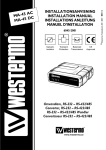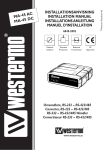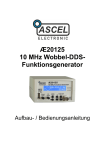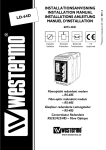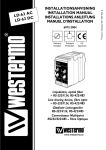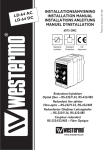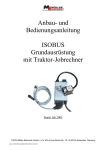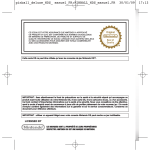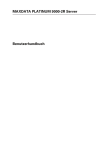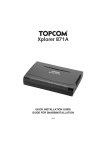Download MD-45 LV
Transcript
INSTALLATIONSANVISNING INSTALLATION MANUAL INSTALLATIONS ANLEITUNG MANUEL D’INSTALLATION 6157-2002 Galvanic Isolation Transient Protection Balanced Transmission CE Approved Omvandlare RS-232 – RS-422/485 Converter RS-232 – RS-422/485 RS-232 – RS-422/485 Wandler Convertisseur RS-232-RS-422/485 www.westermo.se © Westermo Teleindustri AB • 2001 • REV. A AC 5 4 D M LV 5 4 D M Specifikationer MD-45 Överföring Gränssnitt 1 Asynkront, full/halv duplex eller simplex EIA RS-232-C/ITU-T V.24 9-polig D-sub, hylsa eller 9-polig skruvplint EIA RS-422/RS-485/ITU V.11, 5-polig skruvplint 1 200 bit/s – 115,2 kbit/s Power, RD, CTS, RTS, TD 5–50°C, omgivningstemperatur 0–95% RH, utan kondensation 55x100x128 mm (BxHxD) 0,5 kg AC / 0,25 kg LV På 35 mm DIN-skena Gränssnitt 2 Överföringshastighet Lysdioder Temperaturområde Fuktighetsområde Mått Vikt Montering Matningsalternativ Modelbeteckning MD-45 AC MD-45 115 V AC MD-45 LV Strömförsörjning 230 V AC +15/–10% 115 V AC +15/–10% 12–45 V AC +15/–10% Frekvens 48–62 Hz 48–62 Hz 12–60 V DC Säkring, F1 100 mA S 5x20 mm Littlefuse 100 mA S 5x20 mm Littlefuse 1 A T 5x20 mm Wickmann Effektförbrukning 22 mA 44 mA 2W Transientskydd Matning/Linje Ja/Ja Ja/Ja –/Ja Isolation RMS Strömförsörjning Linje 3 000 V 1 500 V 3 000 V 1 500 V 3 000 V 1 500 V Inställningar MD-45 MD-45 kan genom inställningar anpassas till ett flertal olika driftförhållanden. Samtliga omkopplare i MD-45 är åtkomliga när lådans lock avlägsnas. Locket avlägsnas med ett enkelt handgrepp. PWR TD RD RTS CTS Varning! Öppna ej ansluten enhet DSR SG V24/RS-232-C CONNECTION MD-45 LV 2 S1:1-8 1 2 3 4 5 6 7 8 9 S2:1-4 V24/RS-232-C RS-422/RS-485/V11 CONVERTER LINE CONNECTION R+ R- T+ T1 2 3 4 5 POWER – + 6157-2002 Val av hastighet Val av antal bitar ON Hastighet Vändtid S1 9 1 2 3 4 5 6 7 8 ON S1 1 200 780 µs 1 2 3 4 5 6 7 8 ON S1 10 ON 1 2 3 4 5 6 7 8 S1 2 400 410 µs 1 2 3 4 5 6 7 8 ON S1 ON S1 4 800 11 1 2 3 4 5 6 7 8 220 µs 1 2 3 4 5 6 7 8 ON S1 ON S1 9 600 130 µs 19 200 48 µs 38 400 34 µs 12 1 2 3 4 5 6 7 8 1 2 3 4 5 6 7 8 ON S1 2/4-tråds överföring 1 2 3 4 5 6 7 8 ON S1 ON S1 2-tråd 1 2 3 4 5 6 7 8 1 2 3 4 5 6 7 8 ON S1 57 600 22 µs ON S1 1 2 3 4 5 6 7 8 4-tråd 1 2 3 4 5 6 7 8 ON S1 115 200 11 µs 1 2 3 4 5 6 7 8 Terminering med fail-safe * ON S2 Data eller RTS-styrning Terminerad (4-tråd) 1 2 3 4 ON S1 ON Datastyrning S2 1 2 3 4 5 6 7 8 Terminerad (2-tråd) 1 2 3 4 ON S1 RTS-styrning ON S2 1 2 3 4 5 6 7 8 Ingen terminering 1 2 3 4 ON S1 1 2 3 4 5 6 7 8 Sändare alltid aktiv Fabriksinställning * Fail-safe funktionen gör att mottagaren alltid uppfattar signaltillståndet OFF då inkopplad sändare har tillståndet tri-state (sändare ej aktiverad). Terminering skall kopplas in på mottagaren belägen längst bort från sändaren. Hjälptabell för inställning av antal databitar ON 7 bitar 1 2 3 4 5 6 7 8 8 bitar S1 ON S2 Ingen paritet Paritet 1 2 3 4 1 stoppbit S1: 8 används ej 2 stoppbitar Antal bitar 6157-2002 • • • • • • • • • • • • • • • • • • • • • • • • 9 10 10 10 11 11 11 12 3 Anslutningar MD-45 AC Linjeanslutning (5-polig skruvplint) Anslutnings nr. ITU-T V.11 Benämning Mottagare 1 A’ (R+) Mottagare 2 B’ (R–) Sändare 3 A’ (T+) Sändare 4 B’ (T–) 5 Skärm Riktning Definitionen R+/R–,T+/T– kan variera mellan olika tillverkare. Terminalanslutning (DCE) (RS-232-C/V.24, 9-polig D-sub, hylsdon) Riktning Stift nr. Skruvplint nr. ITU-T V.24 Benämning Beskrivning I 3 8 103 TD / Transmitted Data O 2 7 104 RD / Received Data I 7 6 105 RTS / Request to Send O 8 5 106 CTS / Clear to Send O 6 2 107 DSR / Data Set Ready – 5 9&1 102 SG / Signal Ground O 1 4 109 DCD / Data Carrier Detect I = ingång O = utgång på MD-45 Linjekoppling 4-tråd MD-45 1 Mottagare A’ 2 B’ 3 Sändare A 4 B Skärm *) 5 2-tråd RS-422/485 utrustning Tvinnade trådpar A B’ RS-422/485 utrustning Sändare B A’ MD-45 Mottagare Tvinnade trådpar Sändare/ 3 A/A’ A/A’ Mottagare 4 B/B’ B/B’ Skärm *) 5 Sändare/ Mottagare *) Om skärmad kabel används, anslut skärmen endast i en ände för att undvika jordströmmar. 4 6157-2002 Överföringsavstånd (gränssnitt 2) Använd partvinnad kabel. Max ledningslängd 1200 m (gäller för kabel med area 0,3 mm2 och kapacitans 42pF/m) Överföringsegenskaperna förbättras med sänkt kapacitans och ökad kabelarea. I störningsrik miljö bör skärmad kabel användas. MD-45 LV Specifikationer Anslutning Inspänningsområde Effektförbrukning Isolationsspänning Enligt MD-45 AC förutom matning 12–45 V AC, 12–60 V DC 2W Strömförsörjning 3 000 V, linjegränssnitt 1 500 V Säkring, F1 1 A T 5x20 mm Wickmann I övrigt gäller MD-45 AC specifikationerna Ansl. nr. Spänningsanslutning 1 – Spänning 2 + Spänning Inställningar Enligt MD-45 AC 6157-2002 5 Tips RS-422/485 är gränssnitt konstruerade för multidroppapplikationer. Då man kopplar upp en RS-422 alt. RS-485 förbindelse skall man tänka på att installera ett bussnät, d v s det får inte vara förgreningar på kablaget. För att få rätt kabelavslutning skall masteromvandlaren samt den sist anslutna enhetens mottagare termineras. Nedan visas multidroppinstallation med terminering i RS-485 (2-tråds) och RS-422 (4-tråds) kommunikation. Linjesändaren på MD-45 är endast aktiv då data mottages på RS-232 sidan. Om det uppkommer något problem vid inkoppling av MD-45 kan lysdiodsindikeringarna vara till värdefull hjälp vid felsökning. • PWR: Indikerar att enheten är spänningssatt. • RD: Indikerar mottagen data på linjesidan. • CTS: Indikerar samma som RTS. • RTS: Indikerar RTS signalen från inkopplad utrustning. • TD: Indikerar mottagen data på RS-232 sidan. Max 1 200 meter A B Max avstånd 0,3 meter B A B A =Terminering B A Max 32 enheter A’ B’ A B B’ A’ B A B’ A’ B A =Terminering B’ A’ B A Max 32 enheter OBS! R+/R–, T+/T– definitionerna är ej standardiserade, det kan hjälpa att skifta A och B om ej enheten fungerar. 6 6157-2002 ANTECKNINGAR ..................................................................................................................................................................................................................... ..................................................................................................................................................................................................................... ..................................................................................................................................................................................................................... ..................................................................................................................................................................................................................... ..................................................................................................................................................................................................................... ..................................................................................................................................................................................................................... ..................................................................................................................................................................................................................... ..................................................................................................................................................................................................................... ..................................................................................................................................................................................................................... ..................................................................................................................................................................................................................... ..................................................................................................................................................................................................................... ..................................................................................................................................................................................................................... ..................................................................................................................................................................................................................... ..................................................................................................................................................................................................................... ..................................................................................................................................................................................................................... 6157-2002 7 Specifications MD-45 Transmission Interface 1 Interface 2 Data rate Indicators Isolation Temperature range Humidity Dimensions Weight Mounting Power supply alternatives Asynchronous, full/half duplex or simplex EIA RS-232-C/ITU-T V.24 9-position D-sub female, or 9-position screw block EIA RS-422/RS-485/ITU-T V.11, 5-position screw block 1 200 bit/s – 115.2 kbit/s Power, RD, CTS, RTS, TD Galvanic isolation with opto-coupler (data transmission) and transformer (supply) 5–50°C, ambient temperature 0–95% RH, non-condensing 55x100x128 mm (WxHxD) 0.5 kg AC / 0.25 kg LV On DIN-rail 35 mm Model description MD-45 AC MD-45 115 V AC MD-45 LV Power supply 230 V AC +15/–10% 115 V AC +15/–10% 12–45 V AC +15/–10% Frequency 48–62 Hz 48–62 Hz 12–60 V DC Fuse, F1 100 mA F 5x20 mm Littlefuse 100 mA F 5x20 mm Littlefuse 1 A S 5x20 mm Wickmann Power consumption 44 mA 22 mA 2W Transient protection Power/Line Yes/Yes Yes/Yes –/Yes Isolation RMS Power supply Data interface 3 000 V 1 500 V 3 000 V 1 500 V 3 000 V 1 500 V Switch settings MD-45 The MD-45 can through different switch settings be adapted to a variety of operating conditions. To set the switches, open the plastic case by removing the top cover. Danger! Do not open connected unit PWR TD RD RTS CTS DSR SG V24/RS-232-C CONNECTION MD-45 LV 8 S1:1-8 1 2 3 4 5 6 7 8 9 S2:1-4 V24/RS-232-C RS-422/RS-485/V11 CONVERTER LINE CONNECTION R+ R- T+ T1 2 3 4 5 POWER – + 6157-2002 Selection of bits Selection of data rate Data rate Turning time ON S1 9 1 2 3 4 5 6 7 8 ON S1 1 200 780 µs 1 2 3 4 5 6 7 8 ON S1 10 ON 1 2 3 4 5 6 7 8 S1 2 400 410 µs 1 2 3 4 5 6 7 8 ON S1 ON S1 4 800 11 1 2 3 4 5 6 7 8 220 µs 1 2 3 4 5 6 7 8 ON S1 ON S1 9 600 130 µs 19 200 48 µs 38 400 34 µs 12 1 2 3 4 5 6 7 8 1 2 3 4 5 6 7 8 ON S1 2/4-wire transmission 1 2 3 4 5 6 7 8 ON S1 ON S1 2-wire 1 2 3 4 5 6 7 8 1 2 3 4 5 6 7 8 ON S1 57 600 22 µs ON S1 1 2 3 4 5 6 7 8 4-wire 1 2 3 4 5 6 7 8 ON S1 115 200 11 µs 1 2 3 4 5 6 7 8 Termination with fail-safe * ON S2 Data or RTS-control Terminated (4-wire) 1 2 3 4 ON S1 ON Data control S2 1 2 3 4 5 6 7 8 Terminated (2-wire) 1 2 3 4 ON S1 RTS-control ON S2 1 2 3 4 5 6 7 8 No termination 1 2 3 4 ON S1 1 2 3 4 5 6 7 8 Transmitter always active Factory settings * The fail-safe function forces the signal state of the receiver to OFF when the connected transmitter is in tri-state (transmitter inactive). The receiver located furthest away shall be terminated. Supervision table when selecting data bits ON 7 bits 1 2 3 4 5 6 7 8 8 bits S1 ON S2 No parity Parity 1 2 3 4 1 stop bit S1: 8 not used 2 stop bits Number of bits 6157-2002 • • • • • • • • • • • • • • • • • • • • • • • • 9 10 10 10 11 11 11 12 9 Connections MD-45 AC Line connection (5-position screw-terminal) Direction Pin no. ITU-T V.11 Description Receiver 1 A’ (R+) Receiver 2 B’ (R–) Transmitter 3 A’ (T+) Transmitter 4 B’ (T–) 5 Shield The definitions R+/R–,T+/T– can be various between different manufactures. Terminal connection (DCE) (RS-232-C/V.24, 9-position D-sub, female) Direction Pin no. Screwterminal ITU-T V.24 Circuit number I 3 8 103 TD / Transmitted Data O 2 7 104 RD / Received Data I 7 6 105 RTS / Request to Send O 8 5 106 CTS / Clear to Send O 6 2 107 DSR / Data Set Ready – 5 9&1 102 SG / Signal Ground O 1 4 109 DCD / Data Carrier Detect I = input Description O = output on MD-45 Line connection 4-wire 2-wire MD-45 Receiver RS-422/485 equipment Twisted pairs 1 A’ A B’ 3 Transmitter A 4 B Shield *) 5 B RS-422/485 equipment MD-45 Transmitter 2 A’ B’ Twisted pairs Receiver 3 Transmitter/ A/A’ Receiver 4 B/B’ Shield *) 5 A/A’ Transmitter/ Receiver B/B’ *) If shielded cable is used, connect the shield only at one end to avoid ground currents. 10 6157-2002 Transmission range (interface 2) Use twisted pair cable. Max transmission range 1200 m (cable specifications 0.3 mm2 and capacitance 42pF/m). The transmission range will increase if a cable with lower capacitance and larger diameter is used. Use shielded cable in heavy industrial environments. MD-45 LV Specifications Connections Power supply Power consumption Isolation According to MD-45 AC, except power supply 12–45 V AC, 12–60 V DC 2W Power supply 3 000 V, Data interface 1 500 V Fuse, F1 1 A T 5x20 mm Wickmann I övrigt gäller MD-45 AC specifikationerna Connection no. Power Supply 1 – Voltage 2 + Voltage Switch settings According to MD-45 AC 6157-2002 11 Hints RS-422/485 was designed for multidrop applications. When a system is installed it should form a bus structure (see diagrams). Star shaped networks should never be created, there are other Westermo products designed to work in star net applications. To get a correct installation according to the RS-422/485 specification it´s very important that the line is terminated at the correct points. The recommendation is to terminate the receiver on the master unit and the final bus slave unit. See diagrams for details of how this is done with RS-485 (2-wire) and RS-422 (4-wire). The line transmitter used in the MD-45 is activated by data received on the RS-232 interface, unlike conventional converters that rely on a control signal (e.g. RTS). If any problems do occur on set up of the MD-45, the LED’s will be helpful. • PWR: The unit has power. • RD: Data received on the RS-422/485 interface. • CTS: Follows RTS. • RTS: Status of RTS from the RS-232 interface. • TD: Data received on RS-232 interface. Max 1 200 metres A B Max 0.3 metre B A B A =Termination B A Max 32 connections A’ B’ A B B’ A’ B A B’ A’ B A =Termination B’ A’ B A Max 32 connections N.B. R+/R–, T+/T– definitions are not standard, it can help to shift A and B if the unit does not work. 12 6157-2002 OWN COMMENTS ..................................................................................................................................................................................................................... ..................................................................................................................................................................................................................... ..................................................................................................................................................................................................................... ..................................................................................................................................................................................................................... ..................................................................................................................................................................................................................... ..................................................................................................................................................................................................................... ..................................................................................................................................................................................................................... ..................................................................................................................................................................................................................... ..................................................................................................................................................................................................................... ..................................................................................................................................................................................................................... ..................................................................................................................................................................................................................... ..................................................................................................................................................................................................................... ..................................................................................................................................................................................................................... ..................................................................................................................................................................................................................... ..................................................................................................................................................................................................................... 6157-2002 13 Technische Daten MD-45 Übertragungsarten Schnittstelle 1 Asynchron, Voll-/Halbduplex oder Simplex EIA RS-232-C/ITU-T V.24 9 polige Sub-D-Buchse, Schraubklemme Schnittstelle 2 EIA RS-422/RS-485/ITU-T V.11, 5-polige Schraubklemme Übertragungsraten 1 200 Bit/s bis 115,2 Kbit/s Leuchtdioden Power, RD, CTS, RTS, TD Isolation Galvanisch Isoliert mittels Optokoppler (Datenübertragung) und Transformator (Spannungsversorgung) Umgebungstemperatur 5–50°C Luftfeuchtigkeit 0–95%, nicht kondensierend Abmessungen 55x100x128 mm (BxHxT) Gewicht 0,5 kg AC / 0,25 kg DC Installation auf 35 mm Din-Schiene Spannungsversorgung Alternativen Modellbezeichnung MD-45 AC MD-45 115 V AC MD-45 LV Stromversorgung 230 V AC +15/–10% 115 V AC +15/–10% 12–45 V AC +15/–10% Frequenz 48–62 Hz 48–62 Hz 12–60 V DC Sicherung F1 100 mA 5x20 mm Littelfuse 100 mA 5x20 mm Littelfuse 1 A 5x20 mm Wickmann Leistungsaufnahme 22 mA 44 mA 2W Transientenschutz Stromvers./Schnittst. Ja/Ja Ja/Ja –/Ja Isolation RMS Stromversorgung Schnittstelle 3 000 V 1 500 V 3 000 V 1 500 V 3 000 V 1 500 V DIP-Schalter Einstellung MD-45 Das MD-45 bietet verschiedene Einstellmöglichkeiten zur Abstimmung auf verschiedenste Betriebsverhälnisse. Um die DIP-Schalter einzustellen muß die Gehäuseabdeckung z.B. mit Hilfe eines Schraubendrehers abgenommen werden. Achtung! Angeschlossene Geräte nicht öffnen PWR TD RD RTS CTS DSR SG V24/RS-232-C CONNECTION MD-45 LV 14 S1:1-8 1 2 3 4 5 6 7 8 9 S2:1-4 V24/RS-232-C RS-422/RS-485/V11 CONVERTER LINE CONNECTION R+ R- T+ T1 2 3 4 5 POWER – + 6157-2002 Anzahl der Datenbits Übertragungsgeschwindigkeit Übertragungsrate Umschalt -zeit ON S1 9 1 2 3 4 5 6 7 8 ON S1 1 200 780 µs 1 2 3 4 5 6 7 8 ON S1 10 ON 1 2 3 4 5 6 7 8 S1 2 400 410 µs 1 2 3 4 5 6 7 8 ON S1 ON S1 4 800 11 1 2 3 4 5 6 7 8 220 µs 1 2 3 4 5 6 7 8 ON S1 ON S1 9 600 130 µs 19 200 48 µs 38 400 34 µs 12 1 2 3 4 5 6 7 8 1 2 3 4 5 6 7 8 ON S1 2/4-Draht Übertragung 1 2 3 4 5 6 7 8 ON ON S1 S1 2-Draht 1 2 3 4 5 6 7 8 1 2 3 4 5 6 7 8 ON S1 57 600 ON 22 µs S1 1 2 3 4 5 6 7 8 4-Draht 1 2 3 4 5 6 7 8 ON S1 115 200 11 µs 1 2 3 4 5 6 7 8 Termination mit fail-safe * ON S2 Data oder RTS-Kontrol 4-Draht Termination 1 2 3 4 ON S1 ON S2 Datenfluß 2-Draht Termination 1 2 3 4 5 6 7 8 1 2 3 4 ON S1 ON RTS-Steuerung S2 Keine Termination 1 2 3 4 5 6 7 8 ON S1 1 2 3 4 5 6 7 8 1 2 3 4 Sender immer aktiv * Die fail-safe Funktion zwingt den Empfänger in AUS-Zustand zu gehen, wenn der angeschlossene Sender im Tri-State Zustand ist (Sender nicht aktiv). Der am weitesten entfernteste Empfänger sollte terminiert werden. Werkseinstellungen Übersichtstabelle für Datenlänge ON 7 Bits 1 2 3 4 5 6 7 8 8 Bits S1 Keine Parität ON S2 Parität 1 2 3 4 S1: 8 nicht benutzt 1 Stop Bit 2 Stop Bit Anzahl der Bits 6157-2002 • • • • • • • • • • • • • • • • • • • • • • • • 9 10 10 10 11 11 11 12 15 MD-45 AC Leitungsanschluß (5-polige Schraubklemme) Anschluß Nr. ITU-T V.11 Beschreibung Empfänger 1 A’ (R+) Empfänger 2 B’ (R–) Sender 3 A’ (T+) Sender 4 B’ (T–) 5 Schirmung Richtung Die Bezeichnungen R+/R–,T+/T– können abhängig vom Hersteller variieren. Terminalanschluß (DÜE) (RS-232-c/V.24, 9-polige Sub-D Buchse) Richtung Pin Nr. Klemme ITU-T V.24 Bezeichnung Beschreibung I 3 8 103 TD / Transmitted Data O 2 7 104 RD / Received Data I 7 6 105 RTS / Request to Send O 8 5 106 CTS / Clear to Send O 6 2 107 DSR / Data Set Ready – 5 9&1 102 SG / Signal Ground O 1 4 109 DCD / Data Carrier Detect I = Eingang O = Ausgang des MD-45 Leitungsanschluß 4-Draht 2-Draht MD-45 Empfänger RS-422/485 Gerät paarverseilte Leitung 1 A’ A B’ B RS-422/485 Gerät MD-45 Sender 2 paarverseilte Leitung 3 Sender 4 Schirm *) 5 3 A A’ B B’ Empfänger Sender/ A/A’ Empfänger 4 B/B’ Schirm *) 5 A/A’ Sender/ Empfänger B/B’ *) Bei Verwendung von abgeschirmten Kabeln den Schirm nur auf einer Seite anschließen um Erdströme zu vermeiden 16 6157-2002 Übertragungsweiten (Schnittstelle2) Benutzen Sie paarverseilte Leitungen. Maximale Übertragungsweite 1 200 m. (bei Kabelspezifikationen von 0,3 mm2 und 42 pF/m). Die Übertragungsweite nimmt bei kleinerer Kapazität und größerem Durchmesser zu. Benutzen Sie abgeschirmte Kabel in schlechter Umgebung. MD-45 DC Technische Daten Anschlüsse Spannungsversorgung 12–45 V AC, 12–60 V DC Leistungsaufnahme 2W Isolationsspannung Spannungsversorgung 3 000 V Datenschnittstelle 1500 V Sicherung, F1 1 A T 5x20 mm Wickmann Siehe MD-45 AC, außer Spannungsversorgung Anschluß Nr. Spannungsversorgung 1 – Pol 2 + Pol Alle anderen Merkmale siehe MD-45 AC DIP-Schalter Einstellungen Siehe MD-45 AC 6157-2002 17 Tips Der Schnittstellenstandard RS-422/485 wurde für Mehrpunktverbindungen entwickelt. Dieser Standard ist für Busnetze (siehe Beispiele) geeignet. Sternnetze sollten vermieden werden. Für eine korrekte Installation eines RS-422/485 sollte an den richtigen Punkten die Termination eingeschaltet werden. Es sollte am Empfänger des Masters und am letzten Slave die Termination eingeschaltet werden. Siehe Beispiele für RS-485 (2-Draht) und RS-422 (4-Draht) Termination. Der Sender des MD-45 wird aktiviert sobald Daten an der RS-232 Schnittstelle empfangen werden, nicht wie normale Konverter die ein Kontrollsignal z.B. RTS benötigen. Bei Problemen mit der Einstellung des MD-42 können die LED´s hilfreich sein: • PWR Das Gerät hat Versorgungsspannung • RD Daten Empfang an der RS-422/485 Schnittstelle • CTS folgt RTS. • RTS zeigt den Status der RS-232 Schnittstelle an. • TD Daten Empfang an der RS-232 Schnittstelle max. 1 200 Meter A B max. 0,3 Meter B A B A =Termination B A max. 32 Geräte A’ B’ A B B’ A’ B A B’ A’ B A =Termination B’ A’ B A max. 32 Geräte Hinweis: Die Bezeichnungen R+/R-, T+/T- sind nicht Standard, es kann bei Problemen helfen, A und B zu tauschen. 18 6157-2002 EIGENE KOMMENTARE ..................................................................................................................................................................................................................... ..................................................................................................................................................................................................................... ..................................................................................................................................................................................................................... ..................................................................................................................................................................................................................... ..................................................................................................................................................................................................................... ..................................................................................................................................................................................................................... ..................................................................................................................................................................................................................... ..................................................................................................................................................................................................................... ..................................................................................................................................................................................................................... ..................................................................................................................................................................................................................... ..................................................................................................................................................................................................................... ..................................................................................................................................................................................................................... ..................................................................................................................................................................................................................... ..................................................................................................................................................................................................................... ..................................................................................................................................................................................................................... 6157-2002 19 Spécifications MD-45 Transmission Interface 1 Interface 2 Vitesse Indicateurs LED Isolation Gamme température Humidité Dimensions Poids Fixation Possibilités d’alimentation Asynchrone, full/half duplex ou simplex EIA RS-232-C/ITU-T V.24 Connecteur sub-D 9 points femelle, DCE ou Bornier à vis 9 points. EIA RS-422/RS-485/ITU-T V.11 Bornier à vis 5 points. 1 200 bit/sec – 115,2 kbit/s Power, RD, CTS, RTS, TD Isolation galvanique avec opto-coupleur (transmission de données) et transformateur (alimentation) 5–50°C température ambiante 0–95% RH non condensé 55x100x128 mm (LxHxP) 0,5 kg AC, / 0,25 kg LV Sur Rail DIN 35 mm Référence Modèle MD-45 AC MD-45 115 V AC MD-45 LV Tension d’alimentation 230 V AC +15/–10% 115 V AC +15/–10% 12–45 V AC +15/–10% Fréquence 48–62 Hz 48–62 Hz 12–60 V DC Fusible, F1 100 mA F 5x20 mm Littelfuse 100 mA F 5x20 mm Littelfuse 1 A S 5x20 mm Wickmann Consommation 44 mA 22 mA 2W Protection Surtension Alimentation/Ligne Oui/Oui Oui/Oui –/Oui Isolation RMS : Alimentation Interface Donnée 3 000 V 1 500 V 3 000 V 1 500 V 3 000 V 1 500 V Configuration des micro-interrupteurs du MD-45 Le MD-45 peut être adapté à différents environnements à l’aide de la configuration des micro-interrupteurs. On accède aux micro-interrupteurs en enlevant le capot supérieur. ATTENTION ! Ne pas ouvrir sous tension PWR TD RD RTS CTS DSR SG V24/RS-232-C CONNECTION MD-45 LV 20 S1:1-8 1 2 3 4 5 6 7 8 9 S2:1-4 V24/RS-232-C RS-422/RS-485/V11 CONVERTER LINE CONNECTION R+ R- T+ T1 2 3 4 5 POWER – + 6157-2002 Sélection du nombre de bits Configuration du débit des données Débit des données Temps de retournement ON S1 9 1 2 3 4 5 6 7 8 ON S1 1 200 780 µs 1 2 3 4 5 6 7 8 ON S1 10 ON 1 2 3 4 5 6 7 8 S1 2 400 410 µs 1 2 3 4 5 6 7 8 ON S1 ON S1 4 800 11 1 2 3 4 5 6 7 8 220 µs 1 2 3 4 5 6 7 8 ON S1 ON S1 9 600 130 µs 19 200 48 µs 38 400 34 µs 12 1 2 3 4 5 6 7 8 1 2 3 4 5 6 7 8 ON S1 Transmission 2/4 Fils 1 2 3 4 5 6 7 8 ON S1 ON S1 2 fils 1 2 3 4 5 6 7 8 1 2 3 4 5 6 7 8 ON S1 57 600 22 µs ON S1 1 2 3 4 5 6 7 8 4 fils 1 2 3 4 5 6 7 8 ON S1 115 200 11 µs 1 2 3 4 5 6 7 8 Terminaison avec niveau de sécurité* Contrôle Retournement ON S2 Terminé (4 fils) 1 2 3 4 ON S1 Flux de Données ON 1 2 3 4 5 6 7 8 S2 Terminé (2 fils) 1 2 3 4 ON S1 Contrôle RTS ON 1 2 3 4 5 6 7 8 S2 No termination 1 2 3 4 ON S1 1 2 3 4 5 6 7 8 Emetteur toujours actif Configuration Usine * La fonction niveau de sécurité force l’état du signal récepteur sur OFF quand l’émetteur connecté est en mode 3 états, (émetteur inactif).Le récepteur le plus éloigné doit être équipé d’une terminaison. Table de contrôle pour sélection du nombre de bits ON S1 7 Bits 1 2 3 4 5 6 7 8 8 Bits ON Pas de parité S2 Parité 1 2 3 4 1 bit de stop S1 : 8 non utilisés 2 bits de stop Nombre de bits 6157-2002 • • • • • • • • • • • • • • • • • • • • • • • • 9 10 10 10 11 11 11 12 21 Connexions MD-45 AC Connexion Ligne (Bornier à vis 5 points) Direction N° ITU-T V.11 Description Récepteur 1 A’ (R+) Récepteur 2 B’ (R–) Emetteur 3 A’ (T+) Emetteur 4 B’ (T–) 5 Blindage Les définitions R+/R–,T+/T– peuvent changer suivant les constructeurs. Connexion Terminal (DCE) (RS-232-C/V.24, Connecteur sub-D 9 points femelle / bornier à vis) Direction point N° Bornier à vis ITU-T V.24 Circuit N° Description I 3 8 103 TD/Donnée transmise O 2 7 104 RD/Donnée reçue I 7 6 105 RTS/Request To Send O 8 5 106 CTS/Clear To Send O 6 2 107 DSR/Data Set Ready – 5 9&1 102 SG/ Masse O 1 4 109 DCD/Data Carrier Detect I = Input (entrée) O = Output (sortie) sur le MD-45 Connexion Ligne 4-fils 2-fils Récepteur Equipement RS-422/485 Paires torsadées MD-45 1 A’ A B’ B Equipement RS-485 MD-45 Emetteur 2 Paires torsadées 3 Emetteur 4 Blindage *) 5 A A’ B B’ Récepteur Emetteur/ 3 A/A’ Récepteur 4 B/B’ Blindage *) 5 Emetteur/ A/A’ Récepteur B/B’ *) Si on utilise un câble blindé, connecter le blindage uniquement à une extrémité afin d’éviter les retours de courant de terre. 22 6157-2002 Distance de transmission (interface 2) La distance de transmission maximale est de 1200 m avec un câble en paire torsadée. (Spécifications câble 0.3 mm2 et capacité de 42pF/m). La distance de transmission augmentera si on utilise un câble ayant une section plus importante et une capacité plus faible. Utiliser un câble blindé dans des environnements industriels intenses. MD-45 LV Caractéristiques Connexions Alimentation 12–45 V AC, 12–60 V DC Consommation 2 W Isolation Alimentation : 3 000 V Interface Données : 1 500 V Fusible F1 1 A T 5x20 mm Wickmann Toutes les autres caractéristiques sont identiques à celles du MD-45 AC Identiques à celles du MD-45 AC excepté l’alimentation Connexion Alimentation N° 1 Tension – 2 Tension + Configuration des micro-interrupteurs Identique à celle du MD-45 AC 6157-2002 23 Conseils Pratiques Le MD-45 utilise une interface RS-422/485. Le standard RS422/485 a été conçu pour des applications multipoints. Le réseau est installé sous la forme d’une structure bus (voir diagramme). Les réseaux en forme d’étoile sont proscrits. Il existe d’autres produits Westermo qui permettent de travailler avec un réseau en étoile. Une installation correcte d’un réseau RS-422/485 doit toujours être équipée d’une terminaison sur les points correspondants. Il est indispensable d’équiper de terminaisons le récepteur de l’unité maître ainsi que le dernier esclave qui termine le bus. Le diagramme ci-contre vous montre comment est réalisée une connexion RS-485 (2fils) et RS-422 (4 fils) La fonction émission utilisée dans le MD-45 peut être activée soit par détection du flux de données reçu sur le port RS-232, soit par le contrôle RTS en modifiant le micro interrupteur correspondant (voir page 3 contrôle retournement). Si un problème survient pendant la configuration du MD-45, les LED de statut peuvent vous aider. • PWR: L’unité est alimentée. • RD: Réception de données sur l’interface RS-422/485. • CTS: Suit le signal RTS. • RTS: Statut du signal RTS provenant de l’interface RS-232. • TD: Réception de données sur l’interface RS-232/V.24 Max 1200 mètres A B 0,3 mètre Max B A B A =Terminaison B A 32 connexions Max A’ B’ A B B’ A’ B A B’ A’ B A =Terminaison B’ A’ B A 32 connexions Max Nota : Les définitions R+/R-,T+/T- ne sont pas standard. On peut résoudre dans certains cas des problèmes de connexion en inversant les fils A et B si les équipements ne fonctionnent pas. 24 6157-2002 Vos Remarques ..................................................................................................................................................................................................................... ..................................................................................................................................................................................................................... ..................................................................................................................................................................................................................... ..................................................................................................................................................................................................................... ..................................................................................................................................................................................................................... ..................................................................................................................................................................................................................... ..................................................................................................................................................................................................................... ..................................................................................................................................................................................................................... ..................................................................................................................................................................................................................... ..................................................................................................................................................................................................................... ..................................................................................................................................................................................................................... ..................................................................................................................................................................................................................... ..................................................................................................................................................................................................................... ..................................................................................................................................................................................................................... ..................................................................................................................................................................................................................... 6157-2002 25 Block diagram V.11/RS-422 RS-485 V.24/RS-232 TD LED TD 3 3 RTS LED 4 S2:4 7 RTS A B S2:3 CTS LED CTS +5V 8 B Bus termination 0V B MCU DSR 6 +5V B Bus termination +5V S2:2 0V B RD LED S2:1 RD SG 2 5 S1:6 1 0VA 2 +5VA 0VB 5 A' B' Shield 0VA +5V B Insulated power supply 0VB Westermo Teleindustri AB • SE-640 40 Stora Sundby, Sweden Phone +46 16 42 80 00 Fax +46 16 42 80 01 E-mail: [email protected] • Westermo Web site: www.westermo.se Subsidiaries Westermo Data Communications Ltd Unit 14 Talisman Business Centre • Duncan Road Park Gate, Southampton • SO31 7GA Phone: +44(0)1489 580 585 • Fax.:+44(0)1489 580586 E-Mail: [email protected] • Web: www.westermo.co.uk Westermo Data Communications GmbH Goethestraße 67, 68753 Waghäusel Tel.: +49(0)7254-95400-0 • Fax.:+49(0)7254-95400-9 E-Mail: [email protected] • Web: www.westermo.de Westermo Data Communications S.A.R.L. 9 Chemin de Chilly 91160 CHAMPLAN Tél : +33 1 69 10 21 00 • Fax : +33 1 69 10 21 01 E-mail : [email protected] • Site WEB: www.westermo.fr Westermo Teleindustri AB have distributors in several countries, contact us for further information. 02-11 Eskilstuna Offset AB, Eskilstuna, Sweden F1 6157-2002 Power supply


























